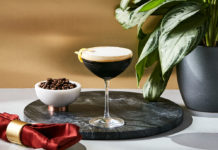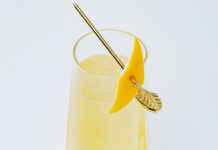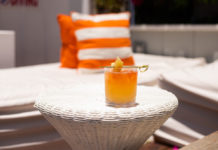
1What are some of the reasons behind sake’s and other Asian spirits’ growth in popularity?
The rise in popularity of sake and other Asian spirits, particularly Asian whisky and shochu, can be credited to the ever-evolving palette and general increase in spirits-related knowledge of the average consumer in any restaurant or bar. We see it in Sunda all the time—people know sake and are familiar with its history. It’s no longer a fad or a novelty. It’s made its way into the mainstream and is here to stay!
2 How is sake being used
on cocktail menus?
Sake has obviously been a staple on Asian or Japanese bar menus for centuries, however, it’s been interesting as of late to witness different kinds of sakes pop up on the cocktails menus of bars and restaurants that have varying concepts unrelated to Asian flavors and ingredients. It’s not just a spirit for Asian spots any more, it’s being used in the mainstream as well.
3 When creating new drinks, how do you choose which kind of sake to incorporate?
In our Sunda cocktails, I treat sake the same as any other cocktail ingredient. Either it’s the focal point, and I add other ingredients to complement it or contrast with it, or I use it to add a layer to the core component of the drink.
4 How do you decide which sakes are featured on the drink menu?
Sake menus should be curated in the same way that wine menus are put together. You have to think about what you’re trying to represent with your list and utilize the sakes that are available in your market to accomplish those goals. At Sunda, in both Chicago and Nashville [the restaurant has two locations], we’re blessed to have access to some amazing sake portfolios in our respective cities so we’re able to offer an array of different styles of sake. So, no matter what kind of flavor profile our guests are craving, we can offer multiple examples that will be delicious.
5What do you think is the best way to experience sake?
Oftentimes the sake brewer has a distinct vision as to how the product should be enjoyed. So, if a sake is brewed with the intention of being served hot or cold, respect should be given in tasting it in that manner. Now, with that being said, don’t be afraid to turn that vision on its head! When you’re trying to create a new cocktail, don’t hesitate to coax a new angle from the sake or say, “screw it,” and couple it with clashing flavors. Think balsamic vinegar and strawberries, sea salt and caramel. Look at how ubiquitous the dirty martini is. Sometimes those pairings surprise and just work.
6 Any advice for how to introduce sake into a cocktail program?
Know your product, first and foremost. Taste, taste, and taste. Find analogues to what people already prefer and use that as an opening to introduce them to a new style of drinking.
7 Any general advice for other mixologists?
Work fast, work clean. Use fresh ingredients. Take care of your bar backs, they’re the backbone of the bar. Give credit where credit is due. Lose the ego. Drink more Malort.
– Erin Spicer









